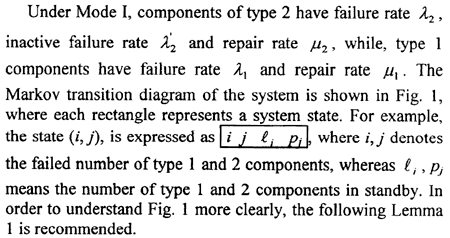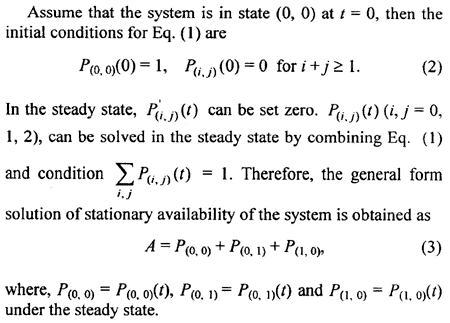In this paper, a 3-Out-of-4:G warm standby system is picked out. It is assumed to be composed of two types of components (or equipment groups), that is, one is the old type (type 2) which has higher failure and lower repair rates and the other is of the new (type 1) which has lower failure and higher repair rates. Therefore, the system can work under two operation modes of Mode I and Mode II. The former is for that the components of type 1 possess priority in operation and repair. While in the latter, components of type 1 have only priority for being repaired. By using Markov model, the analysis approach for system availability and reliability of such system is developed and then the steady-state availability in general form can be obtained. Finally, the solutions of transient availability, reliability and failure frequency of the system under the two operating modes are illustrated by some examples.
2. MODEL
2.1 System Description
There exist some real systems such as power plant and transmission systems where some new equipment groups forced to be added basing on requirements for more output of the system. For example, there is a system that is composed of 4 components with two types named type 1 and type 2. Each type has two components. Type 1 components have lower failure and higher repair rates, while, components of type 2 have higher failure and lower repair rates comparing to type 1. It is required that at least 3 of the 4 components are in operation that the system can be normally operating. Components of type 1 may be arranged to have either standby state or not. Therefore, the system can work in two operating modes, i.e., Mode I and Mode II. In Mode I, components of type 1 do not have standby state, that means, they have priority for operation and being repaired, but components of type 2 can be in operation, failure or standby when the system is used. While in Mode II, each component of the system can be in operation, standby or failure but components of type 1 have priority of being repaired if there is one in the failed. Therefore, this is a 3-Out-of-4:G warm standby system. According to the above description, it has the following assumptions.
2.2 Assumptions
1. The system is 3-Out-of-4:G warm standby one.
2. All states of components are mutually s-independent.
3. Type 1 components with lower failure and higher repair rates have priority of being repaired if there is one in the failed. That means an operative type 2 component will be replaced by one of type I as soon as it is available for the operation from the failed. The component of type 2 being replaced brings back again in standby.
4. Each component in the system is kept constant [operating, dormant] both in failure and repair rates but there is not standby state for type 1 components as far as the system works under Mode I.
5. Two or more components do not fail simultaneously.

7. When a component fails, it is instantaneously replaced by one of the available standbys.
3. AVAILABILITY AND FAILURE FREQUENCY
Markov transition diagram works well not only to analyze system states but also to obtain system availability of a repairable system. Here, Markov transition diagram is utilized to analyze system states and to get solutions of availability and failure frequency of 3-Out-of-4:G warm standby systems with two kinds of components.
3.1 Mode 1

Lemma 1: The system state transition diagram of a repairable standby redundant system with two categories of (M+N) components and priority-operation (equivalently, the other kind has priority-standby) for one kind can be expressed as one with two dimensions. If each system state is regarded as an element of a matrix, that is a matrix with the order at most (M+1) (N+1).
The proof of Lemma 1 is given in Appendix.
A set of differential equations is obtained from Fig. 1 as follows:
P'(t) = M・P(t), (1)
where. P'(t) = (P'(0,0)(t), P' (0,1) (t), ... P'(2,1) (t), P' (2,2) (t)) T,P(t) = (P(0,0) (t), P(0,1) (t), ... P(1,0) (t), P(2,2) (t)) T and M is the transition rate matrix of the system (see Appendix).

Theoretically, taking Laplace transform of Eq. (1) based on the initial condition (2), the Laplace transform of P(i,j) (t) (P(i,j) (s)) is obtained. Further, the solution of P(i,j) (t) is found through the inverse Laplace transform of P(i,j) (s). However, the analytical solution is very difficult to be solved and it needs tedious computation even if it could be obtained. Hence, the system transient availability is then obtained as
A(t) = P(0,0) (t) + P(0,1) (t) + p(1,0) (t) (4)